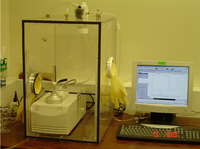Isothermal titration calorimetry

Isothermal titration calorimetry is a big scientific name that helps us understand how molecules in a liquid or solution interact with each other. Imagine you have a bunch of little objects, like building blocks of different shapes and sizes, floating in a glass of water. Now, you want to find out how these building blocks interact with each other when they bump into each other.
Isothermal titration calorimetry helps us measure the heat that is produced or absorbed when these building blocks interact with each other. It's like touching two different objects and feeling if they are hot or cold. To do this, we use a special machine that can measure the heat produced or absorbed when we add one type of building block to the other in small amounts, and then we record how hot or cold the solution gets.
By understanding how much heat is produced or absorbed during these interactions, we can learn a lot about how the building blocks interact with each other, and how they fit together. This can help scientists figure out how different molecules in our body interact with each other, which can help us understand how different diseases work and how to develop new medicines to treat them.
Isothermal titration calorimetry helps us measure the heat that is produced or absorbed when these building blocks interact with each other. It's like touching two different objects and feeling if they are hot or cold. To do this, we use a special machine that can measure the heat produced or absorbed when we add one type of building block to the other in small amounts, and then we record how hot or cold the solution gets.
By understanding how much heat is produced or absorbed during these interactions, we can learn a lot about how the building blocks interact with each other, and how they fit together. This can help scientists figure out how different molecules in our body interact with each other, which can help us understand how different diseases work and how to develop new medicines to treat them.
Related topics others have asked about:
